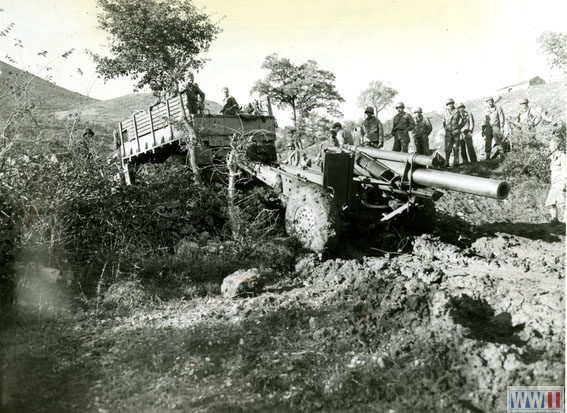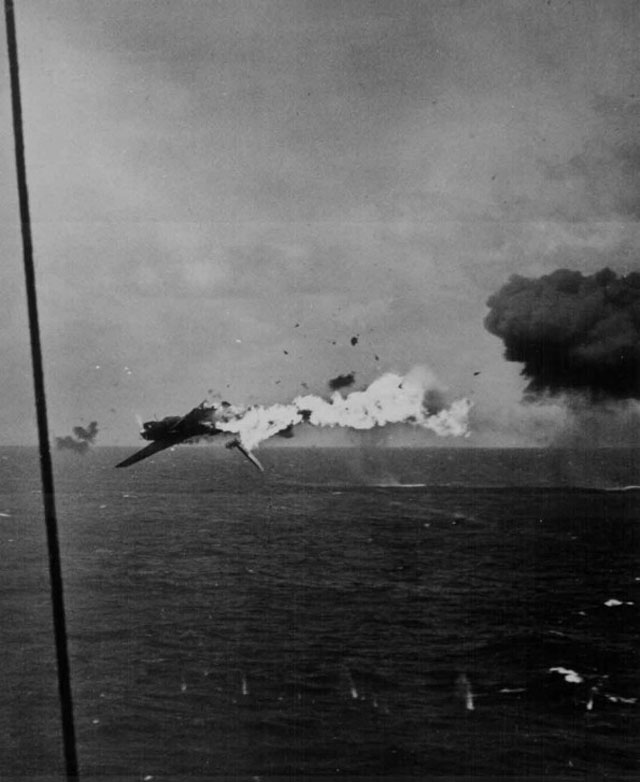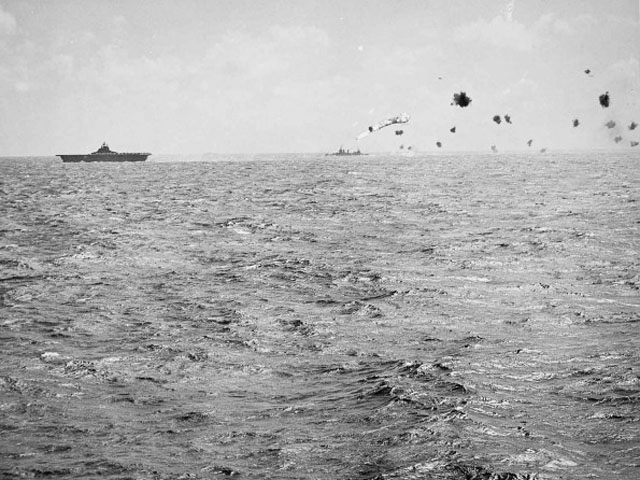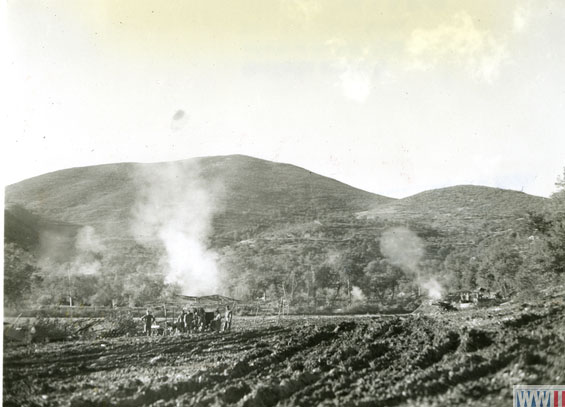Air Operations, Bismarcks
Nearly 50 V Bomber Command heavy and medium bombers attack the Cape Gloucester airfield on New Britain and coastal targets.
[Air Operations, CBI
BURMA- During the night, 12 7th Heavy Bomb Group B-24s sow mines in the Salween River at Moulmein and 5 B-24s sow mines in the Rangoon River.
- The city of Changte falls to Japanese Army ground forces during the course of a major ground offensive across a 100-mile front in the Tungting Lake region. Later, a total of 22 11th Medium Bomb Group B-25s and 38 14th Air Force P-40 fighter-bombers attack the Japanese ground troops in Changte in three waves. P-40s air-drop ammunition to Chinese Army ground troops on Mount Tenshan.
- 23rd Fighter Group P-40s probably destroy 5 Ki-43 'Oscar' fighters over Changte airfield in an engagement lasting from 1340 to 1505, but no confirmed victories are credited.
Air Operations, Central Pacific
8 VII Bomber Command B-24s based at Funafuti attack Nauru Island.
[Air Operations, Europe
USAAFETO:
- The recon phase of Operation CROSSBOW begins with an intense schedule of missions.
NETHERLANDS:
- 16 353rd Fighter Group P-47s dive-bomb the Gilze-Rijen Airdrome under escort from the remainder of the 343rd Fighter Group and the 56th Fighter Group.
- 352nd Fighter Group P-47s conducting a sweep down 3 Luftwaffe fighters near Rotterdam between 1500 and 1510 hours.
- There are no USAAF losses
FRANCE:
- 203 IX Bomber Command B-26s are dispatched against the Chievres (Belgium) and Lille/Vendeville Airdromes, but all are recalled because of bad weather.
Air Operations, Marshalls
- 34 VII Bomber Command B-24s based in the Ellice Islands attack the Mille Atoll, but more than 20 others abort in the face of bad weather.
- US Navy carrier aircraft from Task Force 50 mount 246 effective sorties in two separate missions against the Kwajalein and Wotje atolls. During the morning strike against Kwajalein, Navy TBFs and SBDs sink 4 cargo ships and damage 2 Japanese light cruisers, and 12 F6F strafers destroy 19 Japanese Navy aircraft on the ground at the Roi airfield on Kwajalein. A separate morning strike against the seaplane anchorage at Ebeye Island accounts for 18 floatplanes destroyed at their moorings. US losses are 5 aircraft and 3 pilots.
- US Navy F6Fs down 4 G4M 'Betty' bombers and 34 A6M Zeros over Roi Island and elsewhere over the Kwajalein Atoll between 0705 and 0940 hours. Many other Japanese Navy aircraft are destroyed on the ground at Roi. An afternoon strike against the Wotje Atoll produces negligible results.
- During the noon hour, as the afternoon strike against the Wotje Atoll is being launched, 8 of 8 land-based B5N 'Kate' torpedo bomberss are downed by antiaicraft fire over the carriers. Next, beginning at about 2000 hours, an estimated 30 to 50 G4M 'Betty' bombers and B5N 'Kates' based at the airfields on Kwajalein, Taroa, and Wotje and organized into 14 flights or individually attempt to break through the US Navy antiaircraft umbrella to deliver torpedo attacks in bright flarelight. At 2323 hours, 2 G4M 'Betty' severely damages the USS Lexington with an aerial torpedo. As soon as the night attacks cease, at about 0130 hours on December 5, a second day of US carrier strikes is canceled and Task Force 50 retires to Pearl Harbor. (This precipitous retirement will cost the over-cautious Rear-Adm Charles A. Pownall his job as a task force commander.)
Air Operations, New Guinea
- 12 3rd Light Bomb Group A-20s attack dumps and occupied villages in the Finschhafen area.
- V Fighter Command P-40s attack a bridge at Bogadjim and small craft near Bogia.
Air Operations, Solomons
21 XIII Bomber Command B-24s attack Chabai, which is also attacked by 17 42nd Medium Bomb Group B-25s.
[Allied Planning
The Second Cairo Conference begins. Churchill and Roosevelt meet Pres Ismet Inönü of Turkey. They discuss prospects of bringing Allied troops to Turkey. Amphibious operations in the Bay of Bengal are cancelled because of the need for landing craft in the projected invasion of southern France. A timetable is set for the Pacific 'island hopping' campaign. The conference will end December 7.
[Bolivia
Bolivia declares war on all Axis states.
[Bougainville
The Marines receive a further reinforcement in the form of the 1st Parachute Battalion and are therefore able to extend their perimeter.
[CBI
CHINAThe Japanese 11th Army, in the course of one of its periodic 'rice offensives', takes the town of Chang-te in the Lake Tung-ting area. The object of this offensive is not only to ransack the rice stores but also to prevent the concentration of Chinese troops. The Japanese withdraw soon after taking Chang-te.
[Eastern Front
The Germans crush the Russian forces in the Eltigen bridgehead. About 10,000 are killed and 2,826 are taken prisoner.
[Italy
In the US 5th Army's British X Corps area, the 56th Division is unable to regain Monastery Hill but seizes Hills 683 and 615. In the II Corps area, a German counterattack forces the 1st SSF from Monte la Remetanea to Monte la Difensa. The 1st Regiment moves up to assist thw 2nd in clearing the Monte la Remetanea-Monte la Difensa ridge. The 142nd Infantry, 36th Division, maintains positions on Monte Maggiore. In the VI Corps area, the 135th Infantry, 34th Division, relieves all elements of the 168th Infantry on Monte Pantano. The 168th has suffered heavy casualties.
[Marshall Islands
Adms Charles A. Pownall and Alfred E. Montgomery lead 6 US carriers and 9 cruisers to attack Kwajalein. 386 planes are in the attack. 6 Japanese transports are sunk and 2 cruisers damaged. Also 55 aircraft are shot down for the loss of 5 to the attackers. The aircraft carrier Lexington (CV-16) is damaged by a torpedo from a Japanese aircraft, and the light cruiser Mobile (CL-62) suffers severe damage from an accidental explosion. In a subsidiary operation Yorktown (CV-10) raids Wotje.
[Pacific
- The dates for the landings on Arawe peninsula and Cape Gloucester, in New Britain, are confirmed for December 15 and December 26.
- The US submarine Tinosa (SS-283) sinks the Palau-bound Japanese fleet tanker Azuma Maru (6646t) northwest of Sonserol.
Yugoslavia
Gen Tito becomes chairman of the Committee for National Defense in the newly formed provisional government in liberated territories.
[Images from December 4, 1943
|
|
|
|



